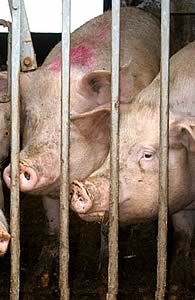 |
|||||||||
|
|||||||||||||||||||
|
|
NADIS
Pig Health Report for February 2008 17/03/08 The National Animal Disease Information Service (NADIS) is a veterinary based clinical reporting and surveillance system based on reports by veterinary surgeons on their farm visits. As well as recording anecdotal remarks on health issues (summarised in the monthly NADIS report), production and health data is also collected.
Whilst NADIS reporting veterinary surgeons continue to draw attention to the number of producers deciding to leave the industry, on a more positive note the wider use of Circovirus vaccines is being highlighted with generally encouraging result. Use of vaccine in sows is now well established with many herds seeing the benefits. Vaccination of piglets – either with a dedicated piglet vaccine or with off licence use of sow vaccine (under veterinary direction) is starting to work through farms with high hopes. BPEX Ltd is planning to assess the efficacy of PCV2 vaccines in the pig industry in England in a large scale research survey scheduled to start in April 2008. They plan to measure the improvements in herd health, welfare, mortality rates and physical performance that result from PCV2 vaccination of sows or piglets. In return for providing records of health and performance vouchers will be supplied towards the cost of the PCV2 vaccine used in the trial.
Sows The 2 most prominent features in the reports through February related to productivity through the autumn and most recently disease challenge.
Piglets Scour featured prominently in reports with Rotavirus, E.Coli and Clostridia all seen at variable levels. In some cases these problems have come on the back of an increase in farrowing house throughput (see above) and decline in hygiene standards. Raised piglet mortality was also seen with the different causes attributed by vets including:
Weaners The most positive news filtering through in reports is the, so far often unrealised, improvements resulting from PCV2 vaccination. The early signs are highly encouraging and after 8 years or so of devastating losses it is encouraging to see that active control may now be achievable. Accurate diagnosis remains key to any disease control programmes and the mistake should not be made of assuming that all problems in weaners and growers are rooted in PMWS. Thus, immediate post weaning fading may be as much to do with poor environments, overstocking, feed availability and palatability issues etc. Specific other disease problems featuring prominently in anecdotal veterinary reports included:
Reports were also received of sudden deaths associated with Mulberry Heart Disease/Vitamin E deficiency. Whilst it may seem perverse to suggest that dead pigs can be a good sign, this condition is normally associated with fast growing pigs soon after weaning. It is worth remembering that the modern hybrid growing pig selected for fast lean growth has a high antioxidant requirement and any shortfall in young pig diets may precipitate such problems. It is a condition that you should look out for if post-weaning improvements in health and growth are seen following PCV2 vaccination.
Finishers There were no particular common trends running through reports for growers and finishers through February but the increase in reports of respiratory disease and enteric disease follows the pattern seen in previous years One particularly interesting issue related to long-standing use of PCV2 vaccines. One of the herds that has been using sow vaccine for 15 months with tremendous results initially saw a rise in grower mortality at the turn of the year. Whilst there was always concern that vaccinating the sows to protect piglets via colostrum could risk pushing the disease into older pigs, in this case the triggers for problems appeared to be overcrowding following the marketing difficulties that resulted from FMD restrictions (that are only just easing now); increased numbers of pigs as a result of reduced mortality due to vaccination through the summer and autumn; and reduced air flows in cooler weather. It is a useful lesson that vaccination programmes can only represent a component of health control strategies. Hygiene problems creating ‘pig sick’ buildings were manifest on one unit as severe respiratory and parasite problems with heavy Ascaris worm burdens found at post mortem examination. A number of reporters have been involved in intervention studies to attempt to reduce Salmonella ZAP scores and results are eagerly awaited although the costs of intervention for an infection which is perceived as only rarely affecting pigs will not be welcome unless offset by an improvement in performance that fully covers those costs. Mycoplasma arthritis was suspected in problems of pigs ‘going off legs’. This is an infectious disease caused by Mycoplasma hyosynoviae – a completely different agent to the Mycoplasma which causes Enzootic pneumonia and one which is not controlled by SEP vaccines. This condition causes sudden onset lameness with pigs often ‘off-legs’ and is typically seen in colder weather and often more commonly in gilts, particularly post-pubertal ones, prior to or beyond slaughter weight. Tail biting continues to feature prominently in reports and whilst the prevalence of this is heavily weighted towards slatted accommodation reports were received in February of major outbreaks in straw yard accommodation in undocked pigs – thought in at least one case to be triggered by 2 rogue pigs. As we move into spring, problems to watch out for include:
Mark White BVSc DPM MRCVS Copyright © NADIS 2008 www.nadis.org.uk
|
||||||||||||||||||

|
|
||||||||||||||||||
| home | agri-services | pedigree
pen | news | dairy | beef | machinery property | organisations | site map |
|||||||||||||||||||

